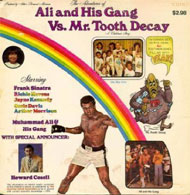| |
Do
you remember going to the dentist to get a cavity filled? No matter
how kindly and skillful your dentist, getting a filling is not
fun. Beyond discomfort, there is also a cost in both time and
money. Cavities are also called dental caries,
and we will be using that more technical name in this month’s
story.
Caries are a widespread problem throughout
the United States. By the age of 40, about 98% of Americans have
had dental caries (Nash and Taubman, 2006). And one-fourth of
Americans suffer from missing teeth or even endentulism as a result
of dental caries. Untreated dental caries can lead to a host of
oral health and overall health problems, including heart disease.
Dental caries is an infectious disease caused
by bacteria in the mouth. What you eat and how you care for your
teeth play a role, too.
Every child is born with a sterile mouth,
but between 18 and 36 months of age, the mouth is colonized by
a variety of bacteria, most notably the bacteria called mutans
streptococci. This is the main culprit in forming caries.
Like all bacteria, the mutans streptococci
bacteria are little living things, so they need food. Guess what
their preferred food is: that’s right it’s sugar.
In particular, it’s the sugar called sucrose, the kind of
everyday sugar you get in little packets and sugar bowls. Mutans
streptococci and sugar act together to makes acids that attack
the teeth.
Here are the steps:
| 1. |
 |
Mutans
streptococci produce an adhesive (sticky) molecule, called
adhesin,
which allows the bacteria to attach to the film on teeth.
Mutans streptococci bacteria that stick to the teeth and the
presence of sucrose lead to dental caries. |
| |
 |
|
| 2. |
|
Mutans
streptococci also produce other enzymes
called glucosyltransferases. Caries form only
when these enzymes and sucrose are present. |
| |
 |
|
| 3. |
|
The glucosyltransferases
break down sucrose into its components, simple sugars known
as fructose and glucose. |
| |
 |
|
| 4. |
|
Mutans
streptococci use these sugars to make new molecules, called
glucans. |
| |
 |
|
| 5. |
|
Glucans
interact with glucan binding proteins and glucosyltransferases
on the surface of the mutans streptococci bacteria. |
| |
 |
|
| 6. |
|
Glucans
and the bacteria accumulate on the teeth and are known as
dental plaque. In other words, dental plaque can
consist of large amounts of mutans streptococci. |
| |
 |
|
| 7. |
|
When
large amounts of plaque form on teeth and when sugars are
present to feed the bacteria, mutans streptococci produce
lactic
acid. The acid makes holes in the teeth, and causing
dental caries. |
Could We Really Have an Anti-Cavity Vaccine?
In order to make a vaccine to prevent dental
caries, it was first necessary to completely understand the mechanism
explained above. Detailing this process of dental caries formation
was spearheaded by Dr. Martin Taubman, his colleague Dr. Daniel
Smith and a team of researchers at The Forsyth Dental Institute
in Boston.
Most of us don’t think of protecting
our teeth with a vaccine, but Drs. Taubman and Smith found that
the immune system can be used to respond
to dental caries. They have been working for over 30 years to
develop a vaccine for dental caries.
Here’s how the immune system defends
the body against foreign invaders (called antigens
): The immune system recognizes, attacks, destroys and eliminates
the invader from the body. Specifically, the immune system activates
cells to make antibodies against the antigen. Each antibody
has a fingerprint that matches a specific antigen. When an antibody
encounters its matching antigen, the antigen is "caught"
and destroyed.
A vaccine is a version of the antigen introduced
into the body on purpose … it is meant to stimulate the
creation of antibodies and protect the person when the real invader
arrives.
So, why not try to create a vaccine for mutans
streptococci bacteria, which is not present when babies are born,
but arrives later, as an invader?
Drs. Taubman and Smith and began this research
in
vitro by stimulating mutans streptococci to make artificial
biofilm (plaque). When sucrose was added, plaque developed.
However, Drs. Taubman and Smith found they could control the amount
of plaque by incubating the bacteria with sucrose and an antibody
to the enzyme glucosyltransferase. To repeat this experiment in
animals, these researchers had to identify an antigen that could
be used to combat the disease.
They used a piece of the enzyme glucosyltransferase,
or a piece of the enzyme as an antigen. They injected this antigen
near the salivary
glands of rats to see if the rats would produce an immune
response. The immunized rats produced the antibody, immunoglobulin
A (IgA) in their saliva and had fewer dental caries. This
led Drs. Taubman and Smith and their team to hypothesize that
glucosyltransferase could be an effective vaccine for the reduction
of dental caries.
To test this hypothesis, twenty-five college
students volunteered either to be immunized with glucosyltransferase
or to be in the control group. Before beginning the experiments
the researchers cleaned the teeth of all of the subjects to minimize
the amount of mutans streptococci present in the mouth. Then they
administered the vaccine by mouth. “The results showed elevation
in antibody and a significant reduction in the recolonization
of the teeth with mutans streptococci,” said Dr. Taubman,
“but this only lasted for up to 42 days. After 42 days the
results from the experimental group were the same as the control
group.” The researchers concluded that, while the vaccine
reduced the amount of bacteria temporarily, adults were not the
right target population for the vaccine.
Researchers believe that the vaccine would
work best if administered before initial bacterial colonization.
Because mutans streptococci colonize the baby’s mouth between
18 and 36 months of age, the correct target population would be
children from 12 to 24 months who have a functioning mucosal
(IgA) immune system.
Since children are the target population,
Drs. Taubman and Smith want to make a vaccine that is really easy
to administer. They are currently developing a way to passively
immunize children by putting the antibody IgA or another antibody,
IgG
directly on children’s teeth or in their mouths before the
bacteria move in. Drs. Taubman and Smith hope that this will enable
the antibody to interfere with the colonization and accumulation
of mutans streptococci.
Dr. Taubman believes that a vaccine against
dental caries is vital. In 2004, it was estimated that 5% of the
total health care budget for the United States was used for preventable
dental care. That would amount to billions of dollars.
Recently, around 20% of US army reservists
could not be deployed to Iraq due to teeth problems. Worldwide,
five billion people suffer form tooth decay. In some areas of
Europe, the rate of endentualism is as high as 78% for people
over 65 years of age. “A vaccine,” says Dr. Taubman,
“could reach many more people and at a much lower cost than
toothbrush, toothpaste, and fluoride or dental fillings.”
He is hopeful that a vaccine will one day
be available one day. But for now, “keep brushing,”
he says. “And flossing couldn’t hurt.”
| Dr. Martin Taubman
is a dentist and immunobiologist at The Forsyth Dental Institute
in Boston and a Professor of Developmental Biology at Harvard
School of Dental Medicine in Boston. |
 |
|
To Learn More:
- Taubman M and Nash D. The scientific and
public-health imperative for a vaccine against dental caries.
Nature Reviews Immunology. 6: 555-563, 2006. Many of the statistics
cited in this month’s story are from this article.
- World Health Organization. World
Oral Health Report
About Dental Caries and Caring for
Your Teeth:
Written by
Rebecca Kranz with
Andrea R. Gwosdow, PhD
Gwosdow Associates
HOME | ABOUT | ARCHIVES | TEACHERS | LINKS | CONTACT
All content on this site is © Massachusetts
Society for Medical Research or others. Please read our copyright
statement — it is important.
|
|
| 
Check out this 1973 educational animation on the relationship
of sweets and tooth decay. Here Mr. Fillings tells a naïve
young tooth about the connection between bacteria, plaque,
sugar and enamel-destroying acid.
You
can see the whole
9-minute video here |

Among other cuts on this unique album, the late, great
Howard Cosell provides narrative as world heavyweight champion
Muhammad Ali KO’s Mr. Tooth Decay in a winner-take-all
brawl. Requires RealPlayer. Also includes Frank Sinatra,
Jayne Kennedy and Richie Havens.
Click
here to listen to an excerpt |
Sign Up for our Monthly Announcement!
...or  subscribe to all of our stories! subscribe to all of our stories!

What A Year! is a project of the Massachusetts Society for Medical Research.
|
|

